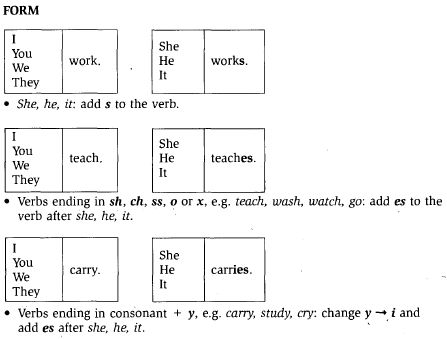Part One : Affirmative form
A / There are only two basic forms for the simple present tense; one ends with -s and the other doesn't. Here are the rules, using the example of the verb to eat
She eats (simple form + s)
It eats (simple form+ s)
You eat (simple form)
They eat (simple form)
IMPORTANT: Only THIRD PERSON SINGULAR subjects (he, she, it) must have a verb with an "s" at the end.
************************************************** **************************
B/ -S or -ES?
With most verbs, the third person singular form is created simply by adding -S. However, with some verbs, you need to add -ES or change the ending a little. Here are the rules:
1/ Verbs ending with "z", "sh" and "ch" "ss" and "o" must take an -es at the third person singular.
Examples
He passes (verb to pass)
He wishes (verb to wish)
She watches (verb to watch)
He buzzes (verb to buzz)
She goes (verb to go)
2/ Verbs ending with a consonant +y : you must change y to i and add 'es'.
Examples:
It flies (verb to fly)
He studies (verb to study)
She carries (verb to carry)

